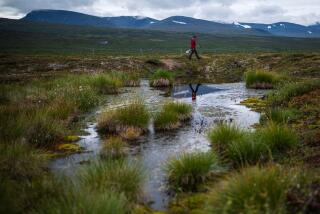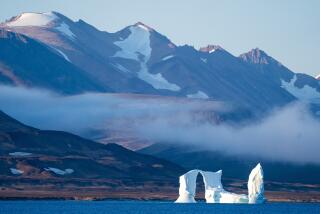Does Antarctic sea ice growth negate climate change? Scientists say no
- Share via
In the blue half-light of the Antarctic autumn, a thin film spreads across the continent’s coastal waters. It’s an embryonic form of sea ice: a mush of microscopic crystals that floats on the dense, salty water of the Southern Ocean.
As winter takes root, this proto-sea ice grows thicker and stronger until it encircles Antarctica in a vast frozen ring. The ice spans nearly 7 million square miles at its peak, an area roughly twice the size of the United States.
This year, Antarctic sea ice has expanded its frigid reach with unprecedented speed, setting records in June and July. By the time spring punctures the long Antarctic night, 2014 stands a decent chance of topping 2012 and 2013, which each broke records of maximum total ice extent.
In fact, since scientists started making satellite observations in the late 1970s, they have watched winter sea ice around Antarctica swell slowly but indisputably, despite predictions that it should shrink.
This poses a puzzle that climate scientists struggle to explain: How can sea ice grow in a warming world?
Climate skeptics have pounced on this apparent discrepancy, citing it as proof that climate change isn’t real, or at least that scientists don’t completely understand it. But those who study Antarctic sea ice say their curious observations shouldn’t shake anyone’s confidence. Dramatic changes in temperature, sea level and extreme weather around the world are proof enough the planet is warming, they say; the only question is how these changes affect the Antarctic as they ripple through the climate system.
“Climate is a complicated thing,” said Ted Maksym, an oceanographer at the Woods Hole Oceanographic Institute in Massachusetts. “Understanding how these kinds of changes play out in different regions is tricky business.”
::
The westerly winds blow fierce and constant around Antarctica, isolating the continent in a kind of permanent polar vortex. Scientists think they exert the most direct control over the state of Antarctic sea ice.
Ice requires cold temperatures to form, and winds help it grow by blowing it around the polar ocean. When the ice moves, new water is exposed to the chilly air, creating an opportunity to make more ice.
In the landlocked Arctic, winter sea ice gets hemmed in by Russia, Greenland, Canada and Alaska, said Thorsten Markus, head of cryospheric sciences at NASA’s Goddard Space Flight Center. But in the Antarctic, unflagging winds push ice ever farther into the empty Southern Ocean.
Those winds have intensified in recent years because of increased concentrations of greenhouse gases in the atmosphere and the presence of the ozone hole. Both serve to magnify the differences in temperature and atmospheric pressure between Antarctica and the tropics, which speed up winds and cause them to swirl faster and more tightly around the continent, said Sharon Stammerjohn, a leading sea ice researcher at the University of Colorado, Boulder.
But it’s not quite as simple as more wind, more ice.
“It makes no sense to talk about a circumpolar average,” Stammerjohn said. “There’s so much regional variability.”
The Ross Sea, which faces New Zealand, has seen a dramatic increase in peak ice extent and 80 more days of ice cover since 1979, when satellites began tracking changes. But along the Antarctic Peninsula, which stretches toward the tip of South America, the ice-covered season in the Bellingshausen Sea is three months shorter than it was 35 years ago.
The sum of both trends is a modest increase in overall sea ice extent. But local effects matter.
“Where we see the strongest decreases in sea ice, we are also seeing dramatic changes to the continental ice sheet,” Stammerjohn said.
For instance, the withering ice cover in the Bellingshausen Sea has occurred adjacent to an imperiled area of the West Antarctic Ice Sheet. Scientists recently announced that it had reached a tipping point and appeared destined to melt no matter what humans did to stem emissions of greenhouse gases. That segment alone has the potential to raise global sea levels by 4 feet.
Scientists say sea ice and continental ice are probably responding to the same forces — namely, changes in ocean circulation and winds. However, they also influence each other. Sea ice helps buffer ice shelves, the floating tongues of glacial ice that dam the ice sheets and keep them from spilling irreversibly into the sea. It also keeps warm ocean waters trapped beneath a frozen lid, insulating the ice sheet from their destructive heat.
In the long run, however, scientists expect Antarctic sea ice to decline everywhere. That it hasn’t done so yet suggests there’s still much to learn about the region.
Antarctica’s remote location and punishing environment make it very difficult to study.
“The instruments we put on the ice get crushed pretty easily,” Stammerjohn said.
The dynamics of the Southern Ocean have also remained elusive. Scientists think changes in the winds have altered ocean circulation, allowing warmer waters below the surface layer to sneak in closer to the shore. These, in turn, may cause glaciers to melt, producing fresh water that freezes at a higher temperature than salt water and thus creates more sea ice. But without long-term observations, it’s hard to measure this effect.
Changes in snowfall may play a role too. In the Antarctic, sea ice grows thicker when new snow falls on top of it, depressing it and flooding it with sea water, which eventually freezes. However, it’s still unclear whether snowfall has increased in Antarctica, said Ron Kwok, a sea ice expert at NASA’s Jet Propulsion Laboratory.
It’s even possible that the current growth spurt is just a short upward wiggle in a larger downward trend. “Thirty years isn’t really that long,” Stammerjohn said.
In January, scientists at New York University offered the most complete explanation yet for the surprising trends in Antarctic sea ice extent. Writing in the journal Nature, they suggested the sea ice distribution in the south could be controlled by ocean temperatures in the North Atlantic Ocean through large-scale changes in atmospheric pressure linked to global warming and natural variability. Other researchers like the idea but say verifying it will take more time.
::
With scientists a bit befuddled, it’s no surprise the public has begun to wonder whether the Antarctic sea ice situation reveals a chink in the climate change story.
Skeptics say it undermines the significance of the much-publicized sea ice loss in the Arctic, where minimum summer sea ice extent has decreased by 30% since the late 1970s. And when a study released last month suggested that Antarctic sea ice growth may have been overstated because of a data calibration error, naysayers called it a brazen attempt by scientists to sweep an inconvenient fact under the rug.
But these critiques oversimplify the science of climate change, Maksym said.
Sea ice is a case in point, he said: “Ironically, one of the possible reasons to get more ice is warming.”
Twitter: @ScienceJulia







